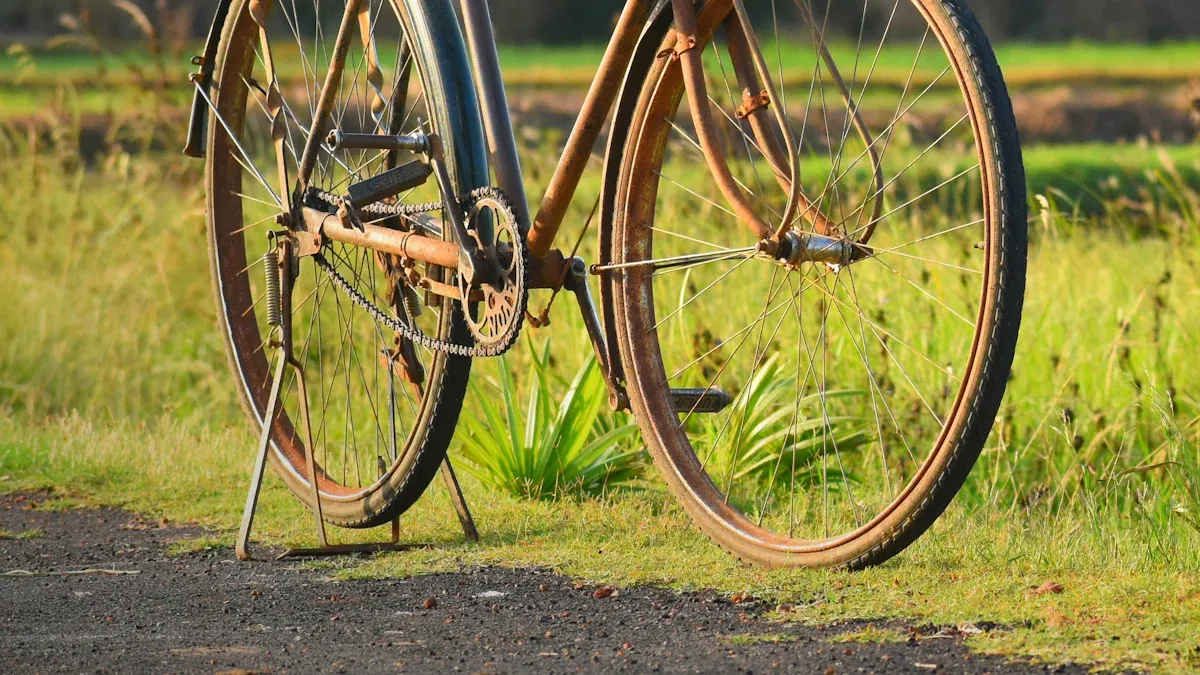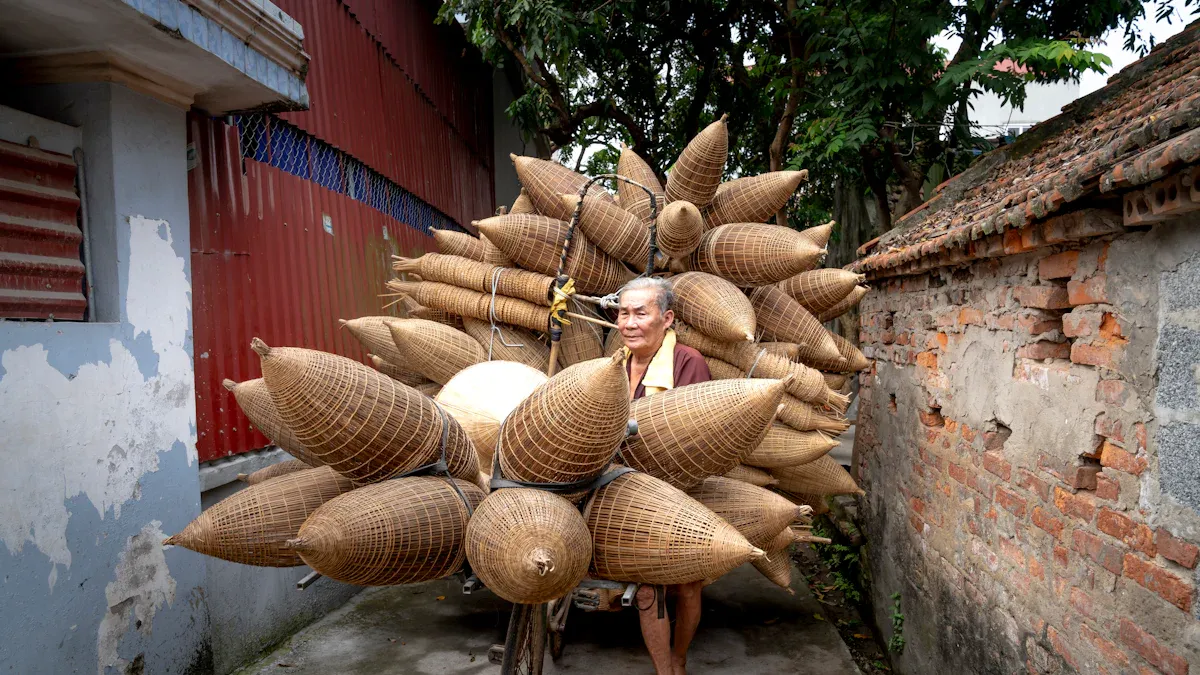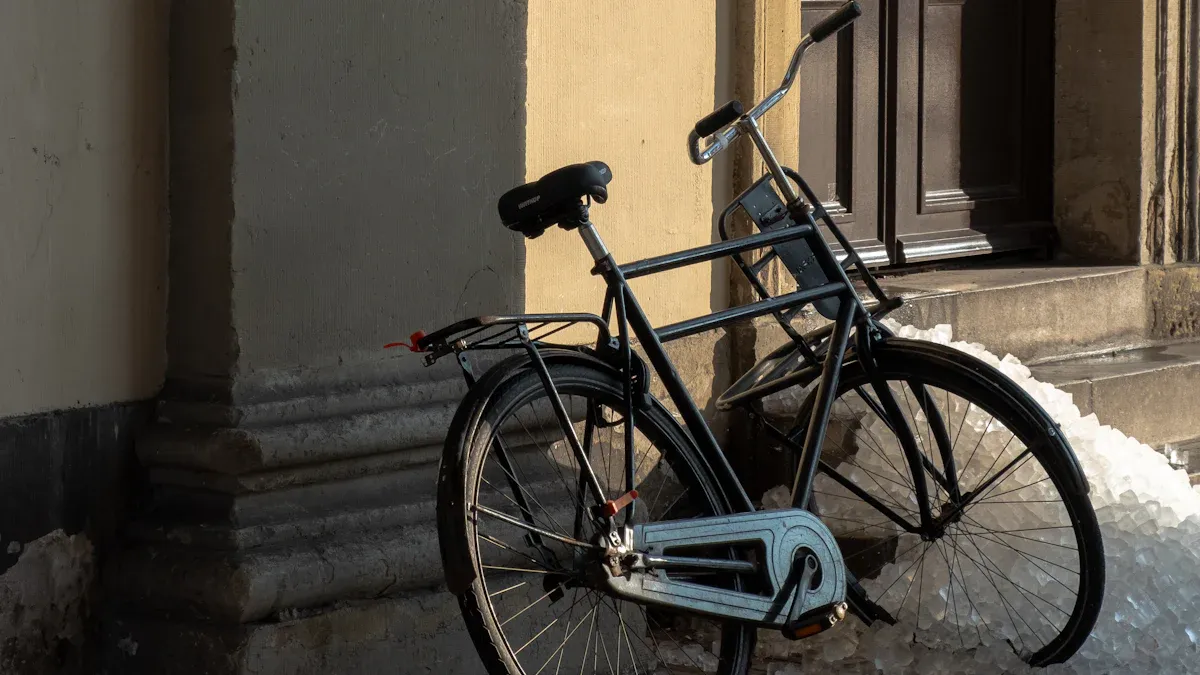
Have you ever thought about riding a bike made from bamboo? These bikes aren’t just unique; they offer incredible benefits! Bamboo frames are lightweight yet strong, making your ride smoother and more enjoyable. Plus, bamboo is a sustainable material that helps reduce your carbon footprint.
Building a bamboo frame bike is simpler than you might think. With just a few tools and some patience, you can create a stunning bike that stands out on the road. Why not give it a try? 🌿
Key Takeaways
Bamboo bike frames are light, strong, and good for the environment. This makes them a smart choice for eco-friendly biking.
Collect all the materials and tools you need before starting. This helps make building easier.
Pick the right bamboo by finding thick, healthy stalks. Heat treat them to make them stronger and last longer.
Use good joining methods like miter and lapped joints. You can also add natural fibers like flax or hemp for more strength.
Protect your bike with coatings to help it last. Check it often for cracks and look at the joints.
Gather Materials

Before you start building your bamboo bike frame, you need to collect all the materials and tools. This will help you save time and avoid problems later. Here’s what you will need:
Essential Tools
You will need some important tools to begin. Here’s a helpful list:
Bamboo: Pick different sizes for the frame parts.
Carbon Fiber Tow: This will make the frame stronger.
Epoxy: Use this to stick the bamboo and carbon fiber together.
Old Bicycle Frame: Get lugs from an old frame to skip making a jig.
Propane Torch: This is important for heating the bamboo.
Basic Hand Tools: Saws, knives, drills, and rotary tools will be useful.
Electrical Tape: Use it to hold carbon fiber while it dries.
Aluminum Angle Bar: This will keep the frame steady while you work.
Threaded Rod and Nuts: These will hold the dropouts in place.
Spar Varnish: Use this to give your frame a nice finish.
Sand Paper: Smooth the surfaces for a clean look.
Rubber Gloves: Wear these to protect your hands when using epoxy.
Required Materials
Now, let’s look at the materials that make your bike frame strong and long-lasting. Here’s a quick summary:
Material | Density (g/cm³) | Notable Properties | |
|---|---|---|---|
Bamboo | 300-350 | 0.4 | Strong, light, and flexible |
Aluminum | 310 | 2.7 | Commonly used and fairly light |
Steel | 370 | N/A | Very strong but heavier than bamboo and aluminum |
Collecting these materials before you begin will make building easier. You will feel more organized and ready to take on each step with confidence. So, take a moment to gather everything you need, and let’s start this fun project! 🌱
Prepare the Bamboo
Before you build your bamboo frame bike, you must prepare the bamboo well. This step is very important for making sure your bike is strong and lasts a long time. Let’s look at how to choose the right bamboo and how to heat treat it to make it stronger.
Selecting Bamboo
Picking the right bamboo is key for your bike frame. Here are some tips to help you find the best bamboo:
Look for Green Bamboo: Fresh bamboo has more moisture. This is good for heat treatment. It helps remove moisture better when heated.
Check for Thickness: Thicker bamboo is usually stronger. Try to find pieces that are at least 1 inch wide for the main frame parts.
Inspect for Damage: Stay away from bamboo with cracks or splits. You want strong, healthy stalks that can handle riding stress.
Consider Species: Different bamboo types have different qualities. Moso bamboo is a popular choice because it is strong and flexible.
Heat Treating Process
After you choose your bamboo, it’s time to heat treat it. This process makes the bamboo much stronger and better for bike frames. Here’s how to do it:
Remove Moisture: Start by heating the bamboo to get rid of moisture. You can use methods like:
Ovens: Put the bamboo in an oven set to about 120 to 140 degrees Fahrenheit.
Butane Torches: Waving a butane torch over the bamboo removes water and burns off the waxy surface. This helps the epoxy stick better later.
Smoking or Drying in Kilns: These methods can also work well to remove moisture.
Heat Treatment Benefits: Heating bamboo changes its starches into a stable material. This makes it less likely to decay and improves strength. Studies show that a two-step heat treatment can greatly improve the strength of bamboo, making it better for your bike frame.
Final Steps: After heat treating, let the bamboo cool down. Once it’s cool, sand the surfaces to get them ready for joining. This will help create a smooth finish and better sticking when you start building your bike.
By carefully choosing and heat treating your bamboo, you create a strong base for making a reliable bamboo frame bike. This preparation helps with durability and improves how well your bike performs.
Construct the Bamboo Frame Bike

Now that you have your bamboo ready, it’s time to build your bamboo frame bike! This step is very important. You will join the bamboo pieces together tightly. Let’s look at how to join them and use flax or hemp strips to make your frame stronger.
Joining Techniques
Joining bamboo needs careful work. Here are some good ways to do it:
Miter Joints: Cut the ends of the bamboo at a 45-degree angle. This gives a bigger area for the epoxy to stick, making the joint stronger.
Butt Joints: Just put the ends of two bamboo pieces together. This method is easy but needs extra care to make a strong bond with epoxy.
Lapped Joints: Overlap two bamboo pieces a little and glue them with epoxy. This method adds strength and stability to the frame.
Tacking: Use small screws or nails to hold the bamboo pieces in place while the epoxy dries. This keeps everything lined up and makes a solid bond.
Tip: Always sand the bamboo surfaces before using epoxy. This helps create a better bond and makes your joints as strong as possible.
Using Flax or Hemp Strips
To make your bamboo frame even stronger, think about using flax or hemp strips with epoxy. These natural fibers give great support for your joints. Here’s how they compare:
Property | Flax/Epoxy | Hemp/Epoxy |
|---|---|---|
50% higher than hemp | Lower than flax | |
Flexural Strength | Lower than hemp | 10% higher than flax |
Tensile Modulus | 60% higher than hemp | Lower than flax |
Flexural Modulus | Lower than hemp | 40% higher than flax |
Elongation at Break | Increased from 4% to 8% | Increased from 2.5% to 3.5% |
Seawater Exposure | Retains better tensile properties | Decreased properties |
Using flax or hemp strips not only makes your joints stronger but also helps the environment. These materials are CO2 neutral. They absorb carbon dioxide while growing, which helps lower your carbon footprint. Plus, making these natural fibers uses less energy than regular materials, which means lower greenhouse gas emissions.
When you are ready to use the strips, cut them to size and lay them over the joints. Then, soak them with epoxy. This will create a strong bond that makes your bamboo frame bike last longer.
By learning these joining techniques and using flax or hemp strips, you will build a strong and eco-friendly bike frame that looks great on the road. Get ready to enjoy your ride!
Assemble the Bike
Now that you have built your bamboo frame bike, it’s time to put the parts together. This step is very important for making sure your bike is safe and ready to ride. Let’s look at how to attach the pieces and keep everything steady.
Attaching Components
First, gather all the parts you need. Here’s a quick list:
Fork: Put the fork on the front of the frame.
Wheels: Add the wheels, making sure they fit well in the dropouts.
Brakes: Securely attach the brakes to the frame.
Handlebars: Put on the handlebars and adjust them for comfort.
Seat: Install the seat and check that it’s the right height.
While you are putting things together, watch out for common problems. Many builders find it hard to align the frame correctly. The shape of the rear triangle can be tricky, which may cause misalignment. If you used a jig for assembly, make sure it is set up right to avoid issues.
Ensuring Stability
Stability is very important for a safe ride. Here are some key safety checks to do while assembling:
Proper Alignment: Check that the frame is aligned correctly. Misalignment can change how your bike rides.
Glue Mixing: Mix your epoxy as the instructions say. This helps create a strong bond and keeps the structure strong.
Use Clamps: Use clamps and a jig to hold everything steady while the glue dries.
Measure Angles: Use a protractor to check angles. Accurate measurements help keep stability.
Protective Finish: Put on a protective finish, like a polyurethane clear coat, to stop damage and water absorption.
Check Rear Dropouts: Measure the alignment of the rear dropouts with a wheel. This makes sure everything fits together well.
By following these steps, you will create a bamboo bicycle that is not only nice to look at but also safe and dependable. Enjoy the process, and soon you will be ready to ride your eco-friendly bike! 🌍
Final Touches and Riding Tips
Now that you have built your bamboo bike, it’s time to add the last details and think about how to keep it in good shape. These steps will help protect your bike and make sure it lasts for many years.
Finishing the Frame
To keep your bamboo frame safe from bad weather, try these finishing methods:
2K Polyurethane Clear Coat: This strong finish protects against rain and wear.
Beeswax Coating: A natural choice that helps keep it safe. Just remember to put it on again every so often.
Epoxy: This waterproof seal stops cracks and fills any small holes in the bamboo.
Varnish: Adds a layer that makes the frame look nice while making it stronger.
Using these finishes not only makes your bike look good but also helps it last longer.
Maintenance Tips
Taking care of your bamboo bike is important for it to last. Here are some tips to remember:
Listen for Cracks: If you hear any strange cracks while riding, it might mean there are problems. Fix these right away.
Check the Bottom Bracket: More bending here can mean it’s not as strong. Look at this area often.
Inspect Joints: Look for cracks at important joints, especially after fixing them. These spots can be weak, so watch them closely.
By following these tips, you’ll have a reliable and eco-friendly ride. Remember, building a bamboo bike is not just about making it; it’s also about taking care of it. Happy riding! 🌍
Making your own bamboo bike frame is a fun adventure! Here’s a quick summary of the main steps:
Get the bamboo ready by choosing the right pieces and heating them.
Build the frame using strong ways to join the pieces.
Put the bike together carefully to keep it stable.
Now that you know the basics, why not share what you’ve done? Join online groups like Sambo’s Bamboo Bike build to meet other builders. Riding a bamboo bike gives you a smooth and comfy ride while helping the planet. With a life of 10-15 years, your eco-friendly bike will be great for many adventures to come! 🌍
FAQ
What type of bamboo is best for bike frames?
Moso bamboo is a popular choice. It’s strong, flexible, and lightweight. Look for pieces that are at least 1 inch thick to ensure durability.
How long does it take to build a bamboo bike?
Building a bamboo bike can take anywhere from a few days to a couple of weeks. It depends on your experience and how much time you dedicate each day.
Can I ride my bamboo bike in the rain?
Yes, you can ride your bamboo bike in the rain. Just make sure to apply a good waterproof finish to protect the bamboo from moisture damage.
How do I maintain my bamboo bike?
Regularly check for cracks and inspect joints. Clean the frame with mild soap and water. Reapply protective coatings as needed to keep it looking great.
Is a bamboo bike as strong as a metal bike?
Yes! Bamboo bikes can be just as strong as metal bikes when built correctly. Bamboo has excellent tensile strength, making it a reliable choice for cycling. 🌿
See Also
Simple Methods for Building a Bamboo Bicycle Frame
Learn to Draw Bicycle Frames Using Simple Techniques
Key Tools and Supplies for Crafting Your Bike Frame
The Trials and Triumphs of Crafting a Wooden Bicycle Frame
Creating a Personalized Stretch Bicycle Frame with Basic Tools
